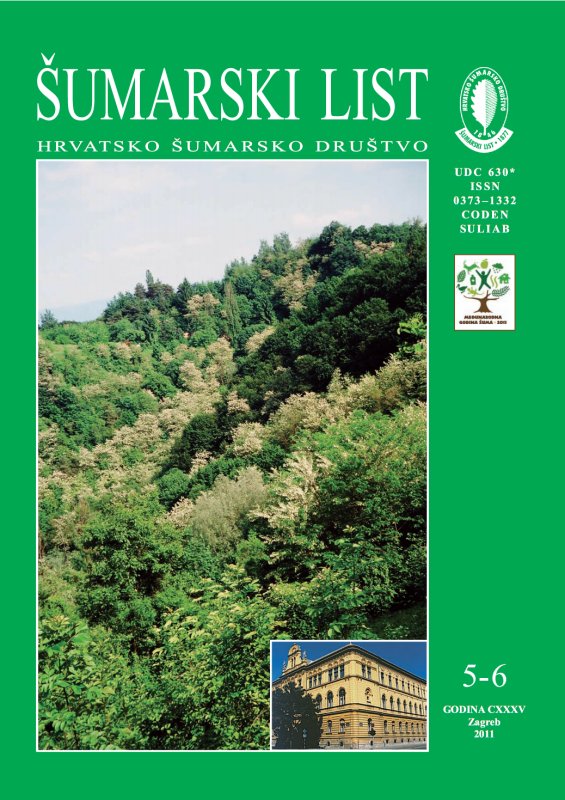
broj: 5-6/2011
pdf (7,5 MB) |
|
||||||||||||||
| RIJEČ UREDNIŠTVA | ||
| Uredništvo | ||
| DEVELOPMENTAL STRATEGY (STRATEGIES) pdf HR EN | 213 | |
| IZVORNI ZNANSTVENI ČLANCI | ||
| Kutnar,L., D. Matijašić, R. Pisek | UDK 630* 907 : 629 + 114.4 (001) | |
| Conservation Status and Potential Threats to Natura 2000 Forest Habitats in Slovenia pdf HR EN | 215 | |
| Summary: An example of the possible use of selected forest-stand based indicators for evaluation of conservation status was shown in case of the Natura 2000 forest habitats of Slovenia, and the potential threats to habitat types were identified. Using the existing forest-management system, and two levels of ICP Forests monitoring as sources of data on the size of habitat, tree composition, developmental phase and stand regeneration, growing stock and increment, dead wood, and level of naturalness of habitat, an attempt of evaluation of the conservation status of the forest habitat types of EU community interest (Habitat Directive 1992, Natura 2000) is presented. In total, the Natura 2000 forest habitat types in Slovenia represent almost one third of all forest area, and the prevailing forest habitat types are Illyrian Fagus sylvaticaforests, Luzulo-Fagetumbeech forests and Illyrian oak-hornbeam forests. Considering the direct influences of human activities and potential effects of climate change the floodplain and lowland forests of Alluvial forests with Alnus glutinosaandFraxinus excelsior, Riparian mixed forests of Quercus roburand other broadleaves, as well as Illyrian oak-hornbeam forest, are among the most threatened forest habitat types. Taking into account the small area of habitat type and the set of different threats, the priority habitat types of Tilio-Acerionforests of slopes, screes and ravines, (Sub-) Mediterranean pine forests and Bog woodland are also endangered. Despite the large number of factors threatening the Slovenian forests, the high level of studied parameters indicates the favourable conservation status of forest habitat types. However, the additional focus on the EU priority habitat types and on rare habitat types on the national level has been suggested to improve the existing forest management planning system, and additional forest-relevant indicators specific to particular habitat types have to be incorporated in the system. Key words: biodiversity; favourable conservation status; forest management planning; habitat type; indicators; monitoring; biodiversity; favourable conservation status; forest management planning; habitat type; indicators; monitoring | ||
| Lubojacký,J., J. Holuša | UDK 630* 453 (001) | |
| Comparison of Spruce Bark Beetle (Ips typographus) Catches Between Treated Trap Logs and Pheromone Traps pdf HR EN | 233 | |
| PRETHODNO PRIOPĆENJE | ||
| Posavec,S., M. Šporčić, D. Antonić, K. Beljan | UDK 630* 649 | |
| Inovation Fostering – Key Factor of Development in Croatian Forestry pdf HR EN | 243 | |
| Planinšek,Š., A. Ferreira, A.Japelj | UDK 630* 116 + 907 | |
| A Model for Evaluation of the Hydrological Role of a Forest pdf HR EN | 257 | |
| STRUČNI ČLANCI | ||
| Poljak,I., M. Idžojtić, M. Zebec | UDK 630* 174 + 652 | |
| Woody Plants of the Zagreb Zoo Garden pdf HR EN | 269 | |
| Domac, J., Z. Benković, V. Šegon, I. Ištok | UDK 630* 537 + 741 | |
| Critical Factors in Developing National Pellet Market pdf HR EN | 281 | |
| ZNANSTVENI I STRUČNI SKUPOVI | ||
| Tomljanović, Kristijan | ||
| Populationsökologie von Raubsäusgarten PDF | 308 | |


